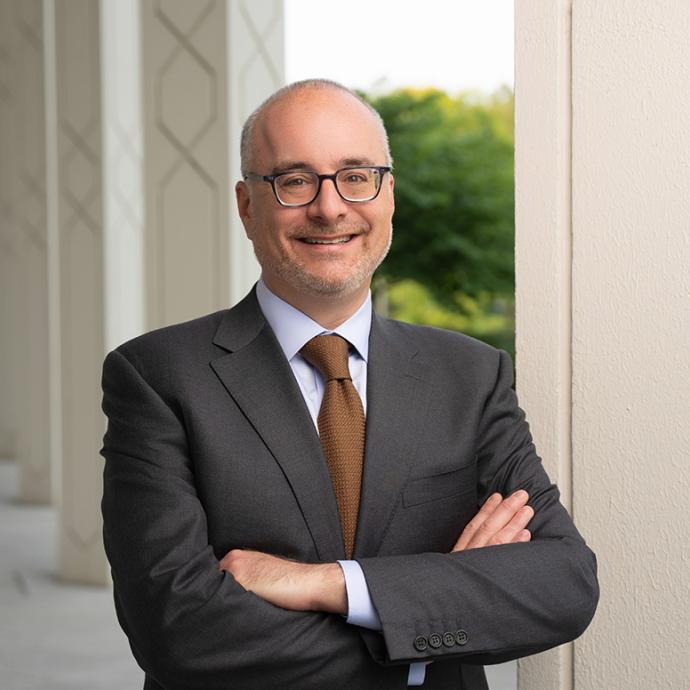Prof. Emeritus Robert N. Clayton, whose pioneering research on the chemistry of meteorites and lunar rocks helped shape the field of cosmochemistry, died on Dec. 30. He was 87.
In the foreword of a book dedicated to Clayton, Smithsonian geologist Glenn MacPherson wrote that Clayton “could easily wear the name ‘Mr. Oxygen.’” Clayton pioneered the use of oxygen isotopes as “fingerprints,” creating a relatively simple test to distinguish meteorites from ordinary rocks as well as a revolution in the burgeoning field of cosmochemistry.
Clayton, the Enrico Fermi Distinguished Service Professor Emeritus in Chemistry, Geophysical Sciences and the Enrico Fermi Institute, joined the University of Chicago faculty in 1958. Early in his career, he studied lunar rocks retrieved by the Apollo missions. His breakthrough came when he tested meteorites for the isotope oxygen-17 in addition to the usually studied oxygen-16 and oxygen-18. To the surprise of everyone in the field, he found that the ratio of these isotopes was extremely unusual, very different from Earth rocks.
The finding offered a scientific mystery that is yet to be fully solved—and a straightforward test to identify meteorites. “It was a profound discovery,” said Prof. Andrew Davis, who chairs the Department of Geophysical Sciences at UChicago and first worked with Clayton as a postdoctoral scholar in the late 1970s, “and it paved the way for a whole new line of inquiry.”
Clayton’s results, published in a seminal 1973 paper, energized the emerging field of cosmochemistry, which uses chemistry as a way to learn not only about meteorite age, source and history but how the planets and bodies formed in the early solar system. Analyzing the isotopes in rock samples reveals information about the conditions under which that rock formed, and the oxygen-17 measurements showed that the meteorites formed by a very unusual chemical process or circumstance. What exactly those circumstances were, and their ramifications for our picture of the early solar system, are still hotly debated.
Along with his longtime research associate, chemist Toshiko Mayeda, Clayton became the go-to source for meteorite analysis. “You’ll find his name on many, many papers describing new meteorites,” said Lawrence Grossman, UChicago professor emeritus in the Department of Geophysical Sciences, who co-authored the 1973 paper with Clayton. “He was really one of the giants of the field of cosmochemistry.”
Though Clayton and Mayeda created a number of tests and techniques widely used in the field, Clayton always performed the oxygen analysis with a ruler, pocket calculator and a 1950s-era vacuum-tube mass spectrometer, now on display in the Henry Hinds Laboratory for Geophysical Sciences. For a quarter of a century, oxygen from virtually every new type of meteorite passed through that spectrometer as Clayton and Mayeda mapped out the isotope ratios for every class of meteorites.
Clayton was also a pioneer in the field of stable isotope geothermometry, which is used in everything from reconstructing temperature changes over millennia as a stalactite forms to reconstructing the climate history of the Earth from polar ice cores. “Bob’s work to measure the distribution of oxygen isotopes between coexisting minerals was a major step in transforming stable isotope geothermometry into a quantitative science,” Davis said.
His colleagues remembered Clayton as an unusually dedicated teacher, always impeccably dressed in a white shirt and tie, with a gift for making complex concepts sound simple and a passion for the fundamentals of chemistry. “He was a great scientist, but one of the underpinnings of his greatness was that he really, truly understood the fundamentals. That’s why he liked to teach first-year chemistry: Those undergrads will ask you questions you haven’t considered in 35 years,” Grossman said.
His daily coffee breaks were a mainstay in the department for decades, drawing noted visitors and regular attendees for their intense scientific and non-scientific discussions. He served as chair of the Department of Geophysical Sciences from 1976-79, as director of the Enrico Fermi Institute from 1998-2001, and as master of the Division of the Physical Sciences' Collegiate Division and associate dean of the Division of the Physical Sciences from 1969-72.
Even in official retirement, he continued to conduct research, meet with students and challenge the field: In 2002, he published a half-page statement in Nature, publically changing his mind on a longstanding argument about whether variability in oxygen isotopes was a result of early star formation or exposure to ultraviolet light. The paper predicted the sun would be five percent richer in oxygen-16 than the rest of the solar system—a finding that was confirmed by the Genesis spacecraft years later.
Clayton was awarded the National Medal of Science, as well as the Geochemical Society’s Goldschmidt Medal, the Urey Medal of the European Association of Geochemistry, and the Meteoritical Society’s Leonard Medal, among others. He was a fellow of the Royal Society of London, the Royal Society of Canada and a member of the National Academy of Sciences.
Clayton is survived by his wife Cathy, daughter Elizabeth and granddaughter Leonora.










 —Prof. Kunle Odunsi
—Prof. Kunle Odunsi
